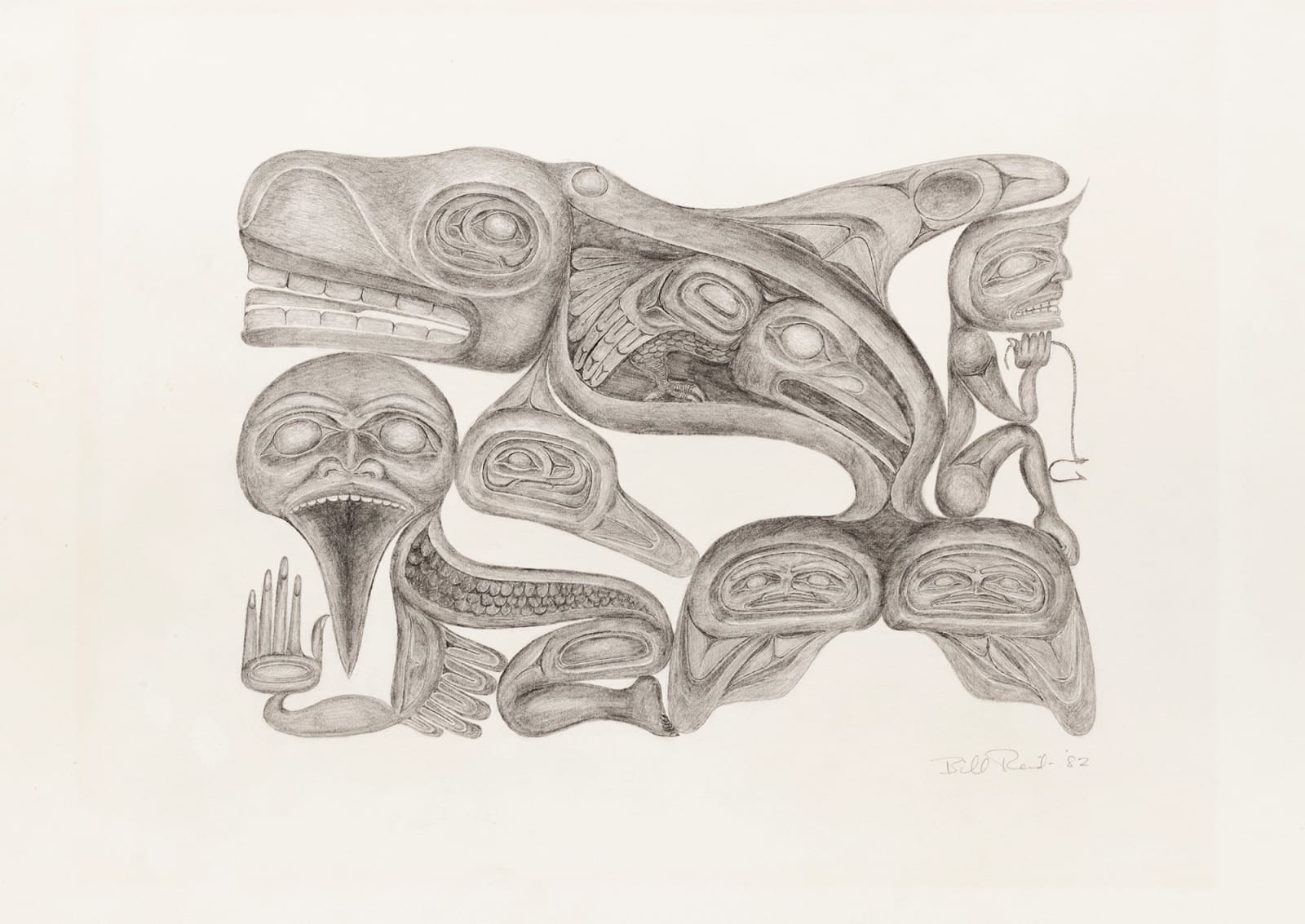-
Artworks
BILL REID, O.B.C., R.C.A. (1920-1998) HAIDA
The Raven with a Broken Beak (Drawing), 1982graphite on pencil, 16.5 x 22.5 in (41.9 x 57.1 cm), framed
signed and dated, "Bill Reid - '82".Further images
Bill Reid led the modern renaissance of Northwest Coast art, producing some of the most iconic and well-documented pieces including Raven and the First Man for the UBC Museum of...Bill Reid led the modern renaissance of Northwest Coast art, producing some of the most iconic and well-documented pieces including Raven and the First Man for the UBC Museum of Anthropology, the Killer Whale in front of the Vancouver Aquarium, and the Black and Jade Canoe for the Canadian Embassy in Washington and the Vancouver airport (also featured on the Canadian $20 bank note). The Bill Reid Gallery of Northwest Coast Art in Vancouver is dedicated to showcasing his work and legacy as well hosting exhibitions of modern Northwest Coast artists and themes. Reid began as a master jeweller but shifted to monumental commissions with the growing demand and recognition for his personal work and for Northwest Coast art in public spaces internationally.
[...]
This drawing is one of ten created as illustrations for the book The Raven Steals the Light by Bill Reid and Robert Bringhurst (published in 1984). Five of the ten drawings, including this one, were also chosen for a portfolio of limited-edition lithographic prints (see Lot 129).
Gary Wyatt
In the publication, Reid dedicates the book to Gyitadzlius or Henry Young, a Haida elder from whom Reid had heard these stories. Rather, self effacingly, describes his contributions (the drawings and texts) "mere glancings of the grand old tales" [1].
This particular story is one of resilience, which tells the story of how the Raven, after being pulped and battered by the "Big Fisherman," was dumped overboard and left for dead. "But," Reid explains, "there was no real danger of that" [2]. Instead, the Raven transformed himself into a salmon, swimming upward from the seabed. However, when nearing the surface, the bird was snatched up by a sghana or killer whale. Transforming back into his true form, the Raven pecked his way out of the whale. After escaping danger once more, the Raven is baited with octopus tentacle by a group of halibut fishermen. A tug-of-war ensues between the fishermen and the bird and the Raven's upper beak "was torn out of his face by its roots and jerked toward the surface" [3]. The Raven, enlisting the help of the killer whale that he had wounded to act as an approaching monster, tricks the fishermen into thinking that his upper beak was a cursed object. The terrified men flee from their camp, leaving their day's catches, supplies, and the Raven's upper beak behind. The Raven resumed his natural form and slid his beak back into place and gorged himself on the freshly caught halibut. Lest we feel bad for the fisherman, the episode ends on a positive note,
"As dawn broke, the fishermen made their way cautiously back to the beach, where they found their fire dead, their catch eaten or spoiled, and the stranger gone. A sad morning indeed, had they not also found on the beach, stranded by the falling tide, the dead killer whale.
The Haidas never hunted the whale themselves, but from that morning to this, they have eaten its flesh with great pleasure whenever they find a fresh killer whale carcass on shore.
So quite inadvertently once again, in the undivided pursuit of his calling — in the relentlessness of his search for amusement and food — the Raven had brought a little pleasure, a little profit and even some knowledge to his favourite playthings, human beings" [4].
The present drawing, The Raven with a Broken Beak, is a testament to Reid's abilities as a draughtsman. Here, his pencil strokes move along the sheet so naturally they appear like breezes made of gossamer fine and assured lines of graphite.
All the elements of the story are illustrated in a thoughtful an balanced composition: one of the fishermen is featured at right with his halibut hook that broke the raven's beak; in the centre, we see the raven in the belly of the killer whale; and the Raven's transformation into a human form is at right.Despite his modesty, "the episodes," as they were dubbed in the 1984 publication, are given life by Reid's extraordinary talent and unique ability to synthesize naturalism with stylization.
1. Bill Reid's introductory text in Bill Reid and Robert Bringhurst, The Raven Steals the Light, (Vancouver: Douglas & McIntyre, 1984), unpaginated.
2. Ibid., p. 42.
3. Ibid., p. 45
4. ibid., p. 48. For the
References: See Robert Bringhurst, ed., The Raven Steals The Light: Drawings by Bill Reid, (Vancouver / Toronto: Douglas & McIntyre / Seattle: University of Washington Press, 1988), pp. 21-48 Reid’s description of the work; The suite of Raven drawings from 1982 is discussed in “Beasts, Monsters and Humans” in Robert Bringhurst, ed., Solitary Raven: The Essential Writings of Bill Reid, (Vancouver: Douglas & McIntyre, 2009), pp. 198-203.
Provenance
With Equinox Gallery, Vancouver;
Collection of John and Joyce Price, Seattle, January 1983.Publications
Illustrated in Bill Reid and Robert Bringhurst, The Raven Steals the Light, (Vancouver: Douglas & McIntyre, 1984), p. 52.
Join our mailing list
* denotes required fields
We will process the personal data you have supplied in accordance with our privacy policy (available on request). You can unsubscribe or change your preferences at any time by clicking the link in our emails.






